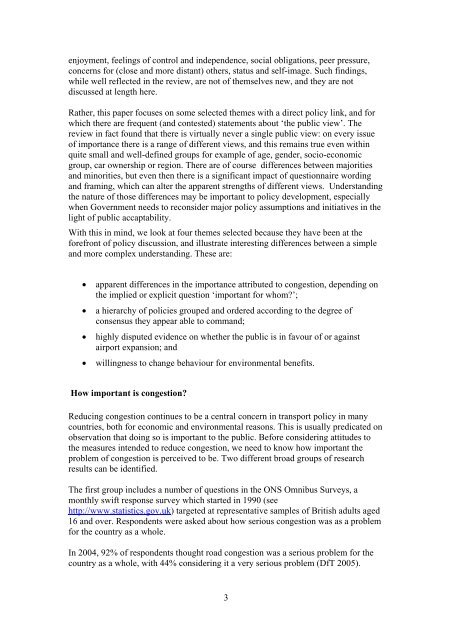Goodwin, P. and Lyons, G. (2009) Public attitudes to transport ...
Goodwin, P. and Lyons, G. (2009) Public attitudes to transport ...
Goodwin, P. and Lyons, G. (2009) Public attitudes to transport ...
You also want an ePaper? Increase the reach of your titles
YUMPU automatically turns print PDFs into web optimized ePapers that Google loves.
enjoyment, feelings of control <strong>and</strong> independence, social obligations, peer pressure,<br />
concerns for (close <strong>and</strong> more distant) others, status <strong>and</strong> self-image. Such findings,<br />
while well reflected in the review, are not of themselves new, <strong>and</strong> they are not<br />
discussed at length here.<br />
Rather, this paper focuses on some selected themes with a direct policy link, <strong>and</strong> for<br />
which there are frequent (<strong>and</strong> contested) statements about ‘the public view’. The<br />
review in fact found that there is virtually never a single public view: on every issue<br />
of importance there is a range of different views, <strong>and</strong> this remains true even within<br />
quite small <strong>and</strong> well-defined groups for example of age, gender, socio-economic<br />
group, car ownership or region. There are of course differences between majorities<br />
<strong>and</strong> minorities, but even then there is a significant impact of questionnaire wording<br />
<strong>and</strong> framing, which can alter the apparent strengths of different views. Underst<strong>and</strong>ing<br />
the nature of those differences may be important <strong>to</strong> policy development, especially<br />
when Government needs <strong>to</strong> reconsider major policy assumptions <strong>and</strong> initiatives in the<br />
light of public accaptability.<br />
With this in mind, we look at four themes selected because they have been at the<br />
forefront of policy discussion, <strong>and</strong> illustrate interesting differences between a simple<br />
<strong>and</strong> more complex underst<strong>and</strong>ing. These are:<br />
• apparent differences in the importance attributed <strong>to</strong> congestion, depending on<br />
the implied or explicit question ‘important for whom?’;<br />
• a hierarchy of policies grouped <strong>and</strong> ordered according <strong>to</strong> the degree of<br />
consensus they appear able <strong>to</strong> comm<strong>and</strong>;<br />
• highly disputed evidence on whether the public is in favour of or against<br />
airport expansion; <strong>and</strong><br />
• willingness <strong>to</strong> change behaviour for environmental benefits.<br />
How important is congestion?<br />
Reducing congestion continues <strong>to</strong> be a central concern in <strong>transport</strong> policy in many<br />
countries, both for economic <strong>and</strong> environmental reasons. This is usually predicated on<br />
observation that doing so is important <strong>to</strong> the public. Before considering <strong>attitudes</strong> <strong>to</strong><br />
the measures intended <strong>to</strong> reduce congestion, we need <strong>to</strong> know how important the<br />
problem of congestion is perceived <strong>to</strong> be. Two different broad groups of research<br />
results can be identified.<br />
The first group includes a number of questions in the ONS Omnibus Surveys, a<br />
monthly swift response survey which started in 1990 (see<br />
http://www.statistics.gov.uk) targeted at representative samples of British adults aged<br />
16 <strong>and</strong> over. Respondents were asked about how serious congestion was as a problem<br />
for the country as a whole.<br />
In 2004, 92% of respondents thought road congestion was a serious problem for the<br />
country as a whole, with 44% considering it a very serious problem (DfT 2005).<br />
3

















